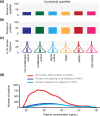Internal Standard Triggered-Parallel Reaction Monitoring Mass Spectrometry Enables Multiplexed Quantification of Candidate Biomarkers in Plasma
- PMID: 35767427
- PMCID: PMC9280723
- DOI: 10.1021/acs.analchem.1c04382
Internal Standard Triggered-Parallel Reaction Monitoring Mass Spectrometry Enables Multiplexed Quantification of Candidate Biomarkers in Plasma
Abstract
Despite advances in proteomic technologies, clinical translation of plasma biomarkers remains low, partly due to a major bottleneck between the discovery of candidate biomarkers and costly clinical validation studies. Due to a dearth of multiplexable assays, generally only a few candidate biomarkers are tested, and the validation success rate is accordingly low. Previously, mass spectrometry-based approaches have been used to fill this gap but feature poor quantitative performance and were generally limited to hundreds of proteins. Here, we demonstrate the capability of an internal standard triggered-parallel reaction monitoring (IS-PRM) assay to greatly expand the numbers of candidates that can be tested with improved quantitative performance. The assay couples immunodepletion and fractionation with IS-PRM and was developed and implemented in human plasma to quantify 5176 peptides representing 1314 breast cancer biomarker candidates. Characterization of the IS-PRM assay demonstrated the precision (median % CV of 7.7%), linearity (median R2 > 0.999 over 4 orders of magnitude), and sensitivity (median LLOQ < 1 fmol, approximately) to enable rank-ordering of candidate biomarkers for validation studies. Using three plasma pools from breast cancer patients and three control pools, 893 proteins were quantified, of which 162 candidate biomarkers were verified in at least one of the cancer pools and 22 were verified in all three cancer pools. The assay greatly expands capabilities for quantification of large numbers of proteins and is well suited for prioritization of viable candidate biomarkers.
Conflict of interest statement
The authors declare no competing financial interest.
Figures





References
-
- Omenn G. S.; et al. Overview of the HUPO Plasma Proteome Project: results from the pilot phase with 35 collaborating laboratories and multiple analytical groups, generating a core dataset of 3020 proteins and a publicly-available database. Proteomics 2005, 5 (13), 3226–45. 10.1002/pmic.200500358. - DOI - PubMed
Publication types
MeSH terms
Substances
Grants and funding
LinkOut - more resources
Full Text Sources
Medical
Miscellaneous

